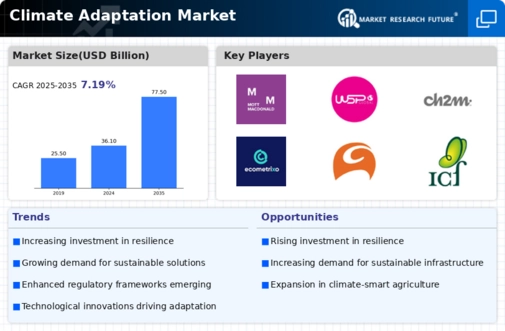Collaboration Across Sectors
Collaboration among various stakeholders is emerging as a vital driver in the Climate Adaptation Market. Partnerships between governments, private sector entities, and non-governmental organizations are essential for developing comprehensive adaptation strategies. These collaborations facilitate knowledge sharing, resource mobilization, and the implementation of best practices. For instance, joint initiatives aimed at enhancing agricultural resilience have shown promising results, leading to improved food security and economic stability. As of 2025, collaborative efforts are expected to account for a significant portion of adaptation funding, potentially reaching 30% of total investments. This trend underscores the importance of collective action in addressing the multifaceted challenges posed by climate change.
Regulatory Frameworks and Policies
The Climate Adaptation Market is increasingly influenced by evolving regulatory frameworks and policies aimed at mitigating climate change impacts. Governments are implementing stringent regulations that mandate climate resilience measures across various sectors, including infrastructure, agriculture, and urban planning. For instance, the adoption of the Paris Agreement has prompted nations to develop national adaptation plans, which are expected to drive investments in climate-resilient projects. As of 2025, it is estimated that compliance with these regulations could lead to a market growth of approximately 15% annually, as organizations seek to align with governmental expectations and avoid penalties. This regulatory push not only fosters innovation but also creates a competitive landscape where businesses that prioritize adaptation strategies are likely to gain a market advantage.
Investment in Sustainable Infrastructure
Investment in sustainable infrastructure is a critical driver of the Climate Adaptation Market. As cities and regions face the realities of climate change, there is a pressing need to upgrade existing infrastructure to withstand extreme weather events. This includes the development of flood defenses, green roofs, and energy-efficient buildings. According to recent estimates, investments in climate-resilient infrastructure could exceed 5 trillion dollars by 2030, reflecting a growing recognition of the need for sustainable development. Such investments not only enhance community resilience but also stimulate economic growth by creating jobs in construction and related sectors. Therefore, stakeholders who prioritize sustainable infrastructure are likely to see substantial returns in the adaptation market.
Increased Public Awareness and Engagement
Public awareness regarding climate change and its associated risks has surged, significantly impacting the Climate Adaptation Market. As communities become more informed about the potential consequences of climate change, there is a growing demand for adaptive solutions that enhance resilience. Surveys indicate that over 70% of individuals are now concerned about climate-related issues, prompting local governments and organizations to prioritize adaptation initiatives. This heightened awareness translates into increased funding for community-based adaptation projects, which are projected to reach a market value of 10 billion dollars by 2026. Consequently, businesses that engage with the public and incorporate community feedback into their adaptation strategies are likely to thrive in this evolving market landscape.
Technological Innovations in Climate Solutions
Technological advancements play a pivotal role in shaping the Climate Adaptation Market. Innovations in data analytics, remote sensing, and artificial intelligence are enabling more accurate climate modeling and risk assessment. These technologies facilitate the development of tailored adaptation strategies that address specific vulnerabilities in various sectors. For example, the integration of smart technologies in urban planning can enhance infrastructure resilience against extreme weather events. As of 2025, the market for climate adaptation technologies is projected to grow by 20%, driven by the increasing demand for efficient and effective solutions. Companies that leverage these technological innovations are likely to gain a competitive edge, positioning themselves as leaders in the adaptation space.


















Leave a Comment